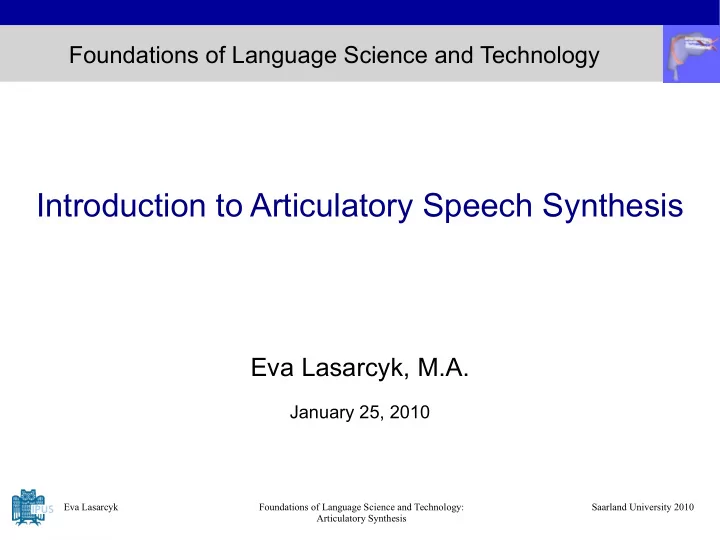

Foundations of Language Science and Technology Introduction to Articulatory Speech Synthesis Eva Lasarcyk, M.A. January 25, 2010 Eva Lasarcyk Foundations of Language Science and Technology: Saarland University 2010 Articulatory Synthesis
Guten Tag, liebe Zuhörer. (Hello, dear listeners.) Eva Lasarcyk Foundations of Language Science and Technology: Saarland University 2010 Articulatory Synthesis
Why speech synthesis? Applications Machine reads aloud text for you handicapped people for authors to check their texts Avatars Telephone dialog systems Natural interaction with service robots Part of "Speech-To-Speech" translation systems Research – phonetic applications Imitate, manipulate, and understand speech production And perception Eva Lasarcyk Foundations of Language Science and Technology: Saarland University 2010 Articulatory Synthesis
How can we create synthetic speech? 3 main strategies Imitate acoustics directly – Formant synthesis Record speech, chop it up, regroup – Concatenative synthesis Imitate, simulate speech production process – Articulatory synthesis Most systems - Long history nowadays use - Some recent major this technique improvements Eva Lasarcyk Foundations of Language Science and Technology: Saarland University 2010 Articulatory Synthesis
Concatenation of speech segments Record speech, chop it up, regroup – Concatenative synthesis Goal: Record a LOT to manipulate LITTLE Trend: Huge databases with intelligent selection of units Advantages Willkommen beim Tag der offenen Tür. Sounds quite natural You need little phonetic knowledge, it's more a signal processing task High quality can be obtained by using a LOT of speech data Disadvantages Data recording costly (time/money) Speaker-dependent, post-hoc manipulations decrease quality, structurally new words may easily sound "funny" Eva Lasarcyk Foundations of Language Science and Technology: Saarland University 2010 Articulatory Synthesis
… "ideal" synthesis should be able to … Cf.: Christine H. Shadle and Robert I. Damper (2001). Prospects for Articulatory Synthesis: A Position Paper. In: Proceedings 4th International Speech Communication Association (ISCA) Workshop on Speech Synthesis, Pitlochry. 121-126. sound as natural & intelligible as a human - highly complex recreate a specific voice - simulation time intensive - high quality create "generic" voices hard to achieve sound like extraordinary speakers (opera singer, alien) speak any language with any emotion without much effort … be freely controllable … allow us insights into speech production and perception Do it yourself: Imitate speech production Physical simulation of sound with an articulatory model Eva Lasarcyk Foundations of Language Science and Technology: Saarland University 2010 Articulatory Synthesis
How are speech waves created? Source + Filter = Speech signal Speech Vocal folds Vocal Tract Eva Lasarcyk Foundations of Language Science and Technology: Saarland University 2010 Articulatory Synthesis
The source: Vocal fold oscillation Different default positions for breathing, speaking and e.g. whispering. Oscillation is not only "open-close" but has a vertical component, too. Eva Lasarcyk Foundations of Language Science and Technology: Saarland University 2010 Articulatory Synthesis
The filter – resonance cavity shapes x-ray movie showing articulation movements during speaking Eva Lasarcyk Foundations of Language Science and Technology: Saarland University 2010 Articulatory Synthesis
Filter: Tongue position of vowels Chart of vocal tract shapes for different vowels Depending on the vowel, the tongue has different shapes Eva Lasarcyk Foundations of Language Science and Technology: Saarland University 2010 Articulatory Synthesis
Now we've almost all we need ... Source + Filter = Speech signal Speech Vocal Vocal folds Tract … to create speech sounds ourselves! Eva Lasarcyk Foundations of Language Science and Technology: Saarland University 2010 Articulatory Synthesis
Mechanical speaking machine Wolfgang von Kempelen image see e.g. http://www.acoustics.hut.fi/p 1791: "Mechanismus der ublications/files/theses/lem menschlichen Sprache nebst metty_mst/chap2.html der Beschreibung einer sprechenden Maschine." One of the first attempts to recreate human speech Available in the Phonetics department Eva Lasarcyk Foundations of Language Science and Technology: Saarland University 2010 Articulatory Synthesis
Vocal tract: Geometrical model Oral cavity Area slice Subglottal system Supraglottal system Mouth Lungs Nostrils Nasal cavity Glottis Glottis Eva Lasarcyk Foundations of Language Science and Technology: Saarland University 2010 Articulatory Synthesis
Supraglottal system /a:/ Hyoid bone (2), lower jaw (3), lips /i:/ (2), velum (1), tongue (12) Eva Lasarcyk Foundations of Language Science and Technology: Saarland University 2010 Articulatory Synthesis
Computer speaking machine – control... Temporal coordination of gestures needs to be controlled A "brain" needs to give the instructions In this synthesis system it is realized by the "gestural score" Eva Lasarcyk Foundations of Language Science and Technology: Saarland University 2010 Articulatory Synthesis
3D articulatory speech synthesizer 3D model Aerodynamic-acoustic Gestural vocal tract; simulation score glottis Main advantage over other synthesis strategies: Speech production becomes transparent VocalTractLab by Peter Birkholz, Eva Lasarcyk Foundations of Language Science and Technology: Saarland University 2010 University Hospital Aachen, Articulatory Synthesis www.vocaltractlab.de
Consonants and vowels vocalic gesture consonantal gesture glottal gesture Only the targets are specified, the transitions are calculated automatically. Sometimes the target realizations change due to the phonetic context (e.g. [g] target in [i:gi:] vs. [u:gu:]) [a:sa: i:si: u:su:] more examples on simple gesture [aSa iSi uSu] patterns ... Eva Lasarcyk Foundations of Language Science and Technology: Saarland University 2010 Articulatory Synthesis
Single gestures: Lips Eva Lasarcyk Foundations of Language Science and Technology: Saarland University 2010 Articulatory Synthesis
Single gestures: Velum Eva Lasarcyk Foundations of Language Science and Technology: Saarland University 2010 Articulatory Synthesis
Gestural score vocalic gestures gestural consonantal control model gestures + dominance velic model gestures glottal gestures F0 (pitch) gestures F0 (pitch) gestures pulmonic gestures Eva Lasarcyk Foundations of Language Science and Technology: Saarland University 2010 Articulatory Synthesis
Recommend
More recommend